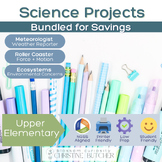Roller Coaster Force and Motion PBL | Project Based Learning Science Enrichment
- PDF
What educators are saying
Also included in
- Project/problem based learning is a great way to teach science and have your students learn through discovery. This bundle includes PBLs that teach force and motion, ecosystems, and meteorology. In the force and motion PBL, students design a roller coaster to illustrate different key content vocabulPrice $12.50Original Price $15.50Save $3.00
Description
Looking for a fun and engaging way to teach about different force and motion or Newton's Laws of Motion?
This project allows students to learn about friction, interia, gravity, speed, momentum, and much more by designing their own roller coaster!
What is project based learning?
Project Based Learning (PBL) is a hands-on way for students to learn as they design, build, and/or research a solution to reach the project's goal or a solution.
The project is broken into parts so students can easily stay on track. An instruction and note taking page are included. The product also includes a rubric, peer review forms, and pictures of student's examples.
Here's how it works:
In this project they will imagine, design, and create a marble roller coaster by examining the different factors that will make the marble roll over two hills.
Topics in this product include:
- force
- motion
- friction
- interia
- gravity
- speed
- momentum
Options for uses:
Since the instructions are so easy for students to understand, it can be given to students who need may not need direct instruction, homework, used as sub plans, maternity leave plans, or test prep.
Please Note:
- If you need suggestions or advice, reach out to me on Instragram @blossom.curiosity




